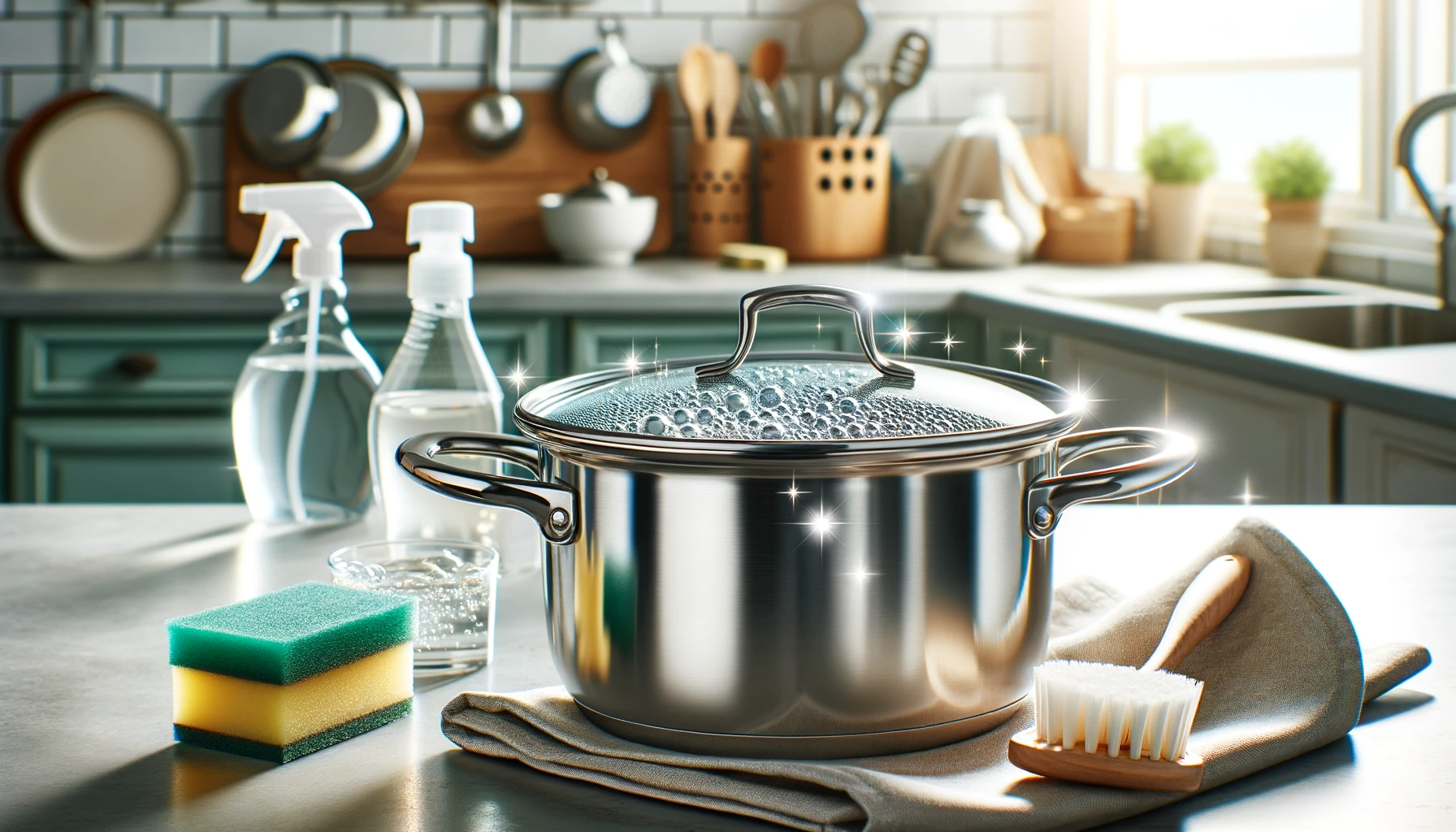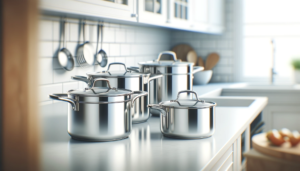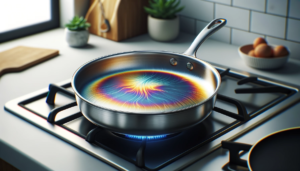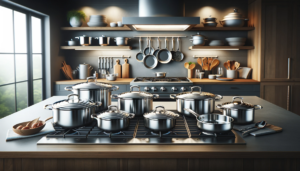If you’ve ever struggled with scrubbing burnt food off of stainless steel pans, you’ll appreciate an easier cleaning routine for keeping Emeril cookware looking pristine after every use.
Implementing a simple yet thorough cleaning regimen after each cooking session prevents unwanted staining and residue buildup that degrade performance over time.
Let’s explore handy techniques for keeping the inside and outside of Emeril stainless pots and pans looking like new for years so you can focus on cooking amazing meals rather than scrubbing.
How to Clean Emeril Stainless Steel Cookware?

The key steps for cleaning Emeril stainless steel pots and pans includes washing with hot, soapy water after each use, using baking soda to remove stuck-on residue, boiling vinegar solutions to eliminate odors, and regularly drying and polishing external surfaces.
A soft sponge or cloth paired with non-abrasive cleaners is best to avoid scratching the durable brushed finish.
Implementing a routine with these methods keeps cookware looking pristine.
We will explore specifics below on how to easily clean both the inside and outside of Emeril pans so they maintain a like-new appearance for years despite constant high heat exposure from cooking.
Supplies That Are Needed for Cleaning Emeril Stainless Steel Cookware

Having the proper cleaning supplies on hand makes washing Emeril stainless steel pots and pans much easier and helps protect the durable finish.
Harsh abrasives like steel wool or scouring pads can eventually damage polished stainless steel surfaces so soft, non-scratch cleaners are best for preserving the look and performance of your cookware.
Basic supplies that are essential for cleaning Emeril stainless steel include dish soap or detergent, baking soda, distilled white vinegar, a soft sponge or dishcloth, and hot water.
The dish soap or detergent helps cut through cooked-on oils and food residue that sticks inside pans after cooking.
Only a small drop or two is needed.
Baking soda serves as a gentle abrasive for scrubbing off stuck-on gunk and stains without scratching stainless steel.
The vinegar helps eliminate unpleasant odors that can linger even after washing.
Soft sponges, cloths, and paper towels clean cookware without scuffing or scratching the finish.
Hot water from the tap helps dissolve residues faster while rinsing away cleaning solution residues that can leave deposits behind.
Having these basic supplies for washing stainless steel on hand under the sink or in a designated cookware cleaning caddy means you can thoroughly clean pans after each use.
This prevents burned on residue from building up and becoming more difficult to remove over time.
Proper post-cooking cleaning also eliminates food odors so your Emeril cookware continues smelling fresh and clean.
Step-By-Step Instructions for Cleaning the Inside of Emeril Pans

After cooking stovetop meals, the inside of stainless steel pots and pans inevitably gets dirty from oil, sauces, and food particles sticking to surfaces.
If not promptly washed out, these residues bake onto pan interiors making thorough cleaning more difficult down the road.
That is why a regular dishwashing routine for the inside of your Emeril cookware is important.
Here is a simple, effective method for cleaning pan interiors after cooking:
Start by filling the warm pan with hot water from your kitchen tap immediately after finishing cooking or dishing up your meal.
The pan should still be warm from stove use, however make sure temperature of water is hot but not scalding as excess heat can warp stainless steel.
Once pan is filled halfway with hot tap water, add a tiny drop of dishwashing liquid or detergent – just 1/4 teaspoon or less is plenty.
Using a soft sponge or dishcloth, gently scrub the interior of the pan, making sure to get into corners.
Apply light scrubbing pressure rather than harsh scouring that could eventually scratch or damage the stainless steel finish over time.
Continue scrubbing for several minutes allowing the hot soapy water to penetrate and dissolve any oily residue.
After scrubbing the pan interior thoroughly, place pan under running tap water to rinse well.
Rinsing away all soap residue is important as leftover detergent can leave deposits contributing to staining in the future.
For an extra fresh scent, do a final rinse with a white vinegar and water solution.
After rinsing away cleaning solutions, avoid air drying which allows mineral deposits left from tap water to bond on metal surfaces.
Instead, immediately hand dry just-washed pans using a soft lint-free dish towel.
Making this thorough washing routine a habit after each use keeps the inside of Emeril cookware looking like new for years.
It also removes food odors right away rather than allowing smells to linger in scratched up pan interiors between uses.
What to Do About Stubborn Baked-On Residue and Staining on Interior Pan Surfaces

Over time with repeated cooking and improper washing, stubborn stains and stuck-on residue can occur on the inside of Emeril stainless steel pans.
Foods that are notoriously problematic include burnt sauces, seared meats, baked casseroles and oils that get overheated.
Even though you may diligently hand wash pans after each meal, avoiding all staining long term can be challenging.
Luckily removing stubborn stuck-on gunk or discoloration inside well used pans is possible without damaging the stainless steel.
The secret weapon is baking soda.
The mildly abrasive qualities provide excellent yet gentle cleaning power against all types of cooked-on messes.
Baking soda even works to remove burnt and browned stains without the need for heavy scrubbing that can warp pan bottoms.
Start by dampening a few stubborn stained or stuck-on areas inside a cooled pan after cooking.
This provides moisture so dried up food residue rehydrates allowing the baking soda solution to better penetrate.
Sprinkle several tablespoons of baking soda directly onto the dampened spots making sure powder fully covers discolored areas.
You can leave the pan dry for spots you cannot dampen first.
Next, use your finger to gently work in several drops of water directly onto the baking soda until it transforms into a thick paste with toothpaste-like consistency.
Let this baking soda paste rest on stuck-on areas of pan interior for approximately 5 to 10 minutes.
This dwell time allows chemical dissolving action to get underway breaking adhesive bonds of food residue before scrubbing begins.
After the paste sits, use a soft damp sponge or cloth to gently scrub stained areas using light force in small circular motions for 30 seconds up to a minute at a time.
Avoid pressing extremely hard or you may leave permanent surface scratches.
Once scrubbed, thoroughly rinse away all baking soda paste residue under hot running water.
Check pan interior after drying to assure stains fully lifted.
For stubborn odors lingering even after baking soda cleaning, do a final pan rinse with undiluted white vinegar followed by extra hot water rinsing.
Repeated baking soda treatments may be needed for especially difficult stains before they completely disappear from stainless steel pan interiors.
How to Remove Lingering Odors from Stainless Steel Cookware

Unwanted smells are commonplace in pans used for cooking pungent foods like garlic, onions and seafood.
But odd odors can also develop when oil, meat or dairy products get overheated and burn onto pan surfaces.
Even with immediate cleaning after cooking, lingering smells sometimes remain trapped in microscopic steel pores of cookware interiors.
Rather than living with unpleasant stainless steel pan odors between meals, removing them is easy using the cleaning and deodorizing power of household vinegar.
White vinegar’s naturally acidic pH breaks adhesive bonds that bind microscopic food particles to metal.
This allows stinky debris releasing from pores so fresh air replaces stubborn smells.
Here is a simple vinegar cleaning method for odor removal inside stainless cookware:
Start by filling the odorous pan about halfway with undiluted plain white vinegar – cider or cleaning vinegars may have added scents.
Turn heat to high setting allowing vinegar solution come a rolling boil inside pan for 2 to 3 minutes.
This rapid boiling action helps amplify vinegar’s odor elimination potency releasing the root source of smells from their embedded positions.
After vigorously boiling, turn off the heat but leave hot vinegar solution resting inside covered pan for approximately 5 more minutes for enhanced odor-removal.
Then drain vinegar from pan and run interior under hot water for a full minute to rinse away any remaining traces of acidic vinegar smell If any faint off-putting odors still linger after water drains, repeat the vinegar boil cleaning one additional time before attempting to use pan for cooking anything new.
In addition to eliminating unwanted odors already present inside Emeril stainless steel pans, vinegar cleaning helps prevent future smells from accumulating by removing microscopic debris pores readily trap.
Make this bimonthly and anytime odors arise for cookware that stays fresher smelling long-term after meals cook.
Steps to Properly Care for the Exterior Surfaces of Emeril Stainless Steel Pots and Pans

While the interiors of pots and pans used for stovetop cooking see the most grime and require thorough cleaning, maintaining exteriors also deserves attention for keeping Emeril stainless steel looking beautiful long term.
The broad exterior pan surfaces get exposed to oils, foods, grease and water during the cooking process.
Over time without care, this leads to stubborn dirt build up degrading the refined brushed metal appearance.
You will need dish soap, hot water, a sponge and soft towel for properly caring and cleaning external cookware surfaces after use.
Avoid using abrasive powders or metal pads that slowly degrade fine finishing over time.
Immediately following cooking, while pans remain warm not hot, liberally apply a few drops dish soap directly onto exterior surfaces.
Using a damp soft sponge, gently scrub the broad exterior paying extra attention to handles and rims with embedded oils and food drips.
Clean along brushed grain lines rather than across for optimal dirt release from textured crevices.
Soap combined with gentle scrubbing lifts and dissolves sticky oils and foods before they permanently bake onto stainless steel finishes once pans fully cool.
After thoroughly scrubbing exterior pan body, rims and handles, carefully rinse all soap residue off under a steady stream of hot water.
Water temperatures exceeding one hundred twenty degrees helps dissolve lingering fatty oils faster than lukewarm tap water while avoiding excessive heat potentially warping pans.
Pay detailed attention to complete rinsing avoiding any soap film remaining helping water droplets and dirt accumulate faster between usages.
As a final step after fully rinsing and draining excess water, immediately hand dry Emeril stainless steel pan exteriors using a fresh soft lint-free cotton towel.
Rub gently to absorb all moisture rather than allowing air drying.
Water evaporation leaves mineral residue buildup on stainless steel surfaces degrading appearance over time through etching and corrosion.
Any droplets left behind set the stage for new water marks and staining when pans eventually get reused for meal preparation.
In addition to washing and hand drying after each kitchen use, occasionally apply a thin layer stainless steel polish or cleaner formulated specifically for maintaining brushed metal finishes.
Use an ultra-soft lint-free cloth distributing polish evenly across broad exterior pan surfaces.
Light buffing gives added sparkle while leaving a protective barrier helping repel fingerprints, oils and water during future cooking endeavors so surfaces stay like new despite frequent use.
Conclusion
Properly caring for Emeril stainless steel cookware ensures it retains the classic good looks and cooking performance for years of service.
By promptly washing interiors after each use and occasionally polishing exteriors, pans maintain a like-new appearance despite constant high heat exposure.
Implementing a simple routine of hot soapy handwashing along with gentle scrubbing preserves the brushed finish that elegantly dresses up any contemporary kitchen.
Treat your cookware well and it will continue delivering delicious meals for a lifetime.



